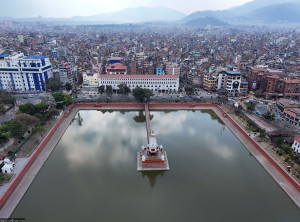Opinion
Neither toys nor collectibles
I hate seeing fish in small cramped tanks in offices and homes. Their large eyes stare at me, begging me to release them into their original homes.
Maneka Sanjay Gandhi
I hate seeing fish in small cramped tanks in offices and homes. Their large eyes stare at me, begging me to release them into their original homes. They cannot swim, play or mate. Locked in these small prisons with other species of fish chosen for their colours rather than their homogeneity, they simply wait to die. They don’t recognise owners, are no fun to interact with and do not speak. They simply adorn a cage on the wall in the same way that inanimate objects would. And when they die, which is very prematurely, they are simply replaced by the seller who looks forward to their deaths as an opportunity to make more money. They lead lives of great suffering and they bring very bad luck to the buyer as their silent sighs fill the air.
These fragile tropical fish, which were born to swim in schools in the rivers and oceans, are in agony when they are forced to spend their lives in glass tanks. Robbed of their natural habitats and denied the ability to swim freely in nature with no boundaries, they must swim around endlessly in the same few cubic inches of water.
Poison with prejudice
Selling tropical fish has been an unregulated industry that earns millions for poachers and pet shops but has virtually denuded our coastal areas of their fish. Poachers get into wildlife sanctuaries where the streams and rivers are still unpolluted and full of rare fish. They pour cyanide into the water after spreading a net. Cyanide does not kill the fish. It knocks them unconscious or sends them into spasms. They are gathered up and put into glass holders. Another way is to throw low grade homemade bombs into the water. The fish come floating up. Some are dead. The fish that survive are taken and sold to people with no knowledge on the fish’s habitat or diet. In the meantime, the cyanide and bombs in the water have killed off thousands of other living beings that inhabit the waters. Cyanide also kills the coral reefs and marine biologists rank it as one of the biggest dangers in Asian waters.
Pet shop owners don’t have much idea of their fish either. For every fish they sell, they lose more than a hundred as the temperature of the tanks is unregulated, the tanks are overcrowded, and some fish are diseased and spread the contagion.
Shop owners buy these fish from poachers and middlemen at ridiculously low prices and sell them at a mark-up of 500 percent, so even the loss of thousands doesn’t matter.
The popularity of keeping tropical fish has created catchers and breeders, who couldn’t care less about the animals themselves and are little better than hunters and butchers. Over 20 million fish, 12 million corals, and 10 million other types of marine life—such as anemones and molluscs—are captured every year to support a $300 million worldwide “hobby.”
Raised in hell
As a result, most fish are endangered species because of the aquarium industry. Removing animals from the wild can have serious consequences—both for their survival as a species and for their habitat. For instance, many fish feed on algae, an organism that could overgrow the coral if the fish didn’t keep it clear. Removing them from a reef could leave corals in jeopardy of being smothered.
Approximately 90 percent of freshwater fish are raised on farms. Goldfish are bred in giant tubs in slum facilities that produce more than a million fish per year. These animals are sold to pet shops and doomed to live in plastic bags or bowls.
Some fish farms forcibly mate different species, creating fish breeds that would never occur in nature and subjecting the new breed to a lifetime of physical ailments.
Some breeders inject fluorescent dyes into the animals’ bodies to make them more attractive to buyers. Common victims of this horrifying practice are semi-transparent fish like Glassfish or light coloured fish such as White Mollies, White Skirt Tetras, albino Corydoras and Parrotfish Cichlids.
Some sell “balloon” shaped fish: Mollies, Guppies and Cichlids. These are deformed to curve the spine and compact the internal organs, resulting in fish that suffer their entire lives.
Since fish are often sold as babies, many people aren’t aware of the size they will reach as adults. Goldfish are the most common victims of this misconception. Unfortunately, once these fish get too large for the average aquarium or fish bowls they will suffer and die.
There is no safe way to return captive fish to their natural environments because of the difficulty in locating a habitat and the possibility of introducing disease to the other fish there.
Fish can recognise individuals, use tools, and maintain complex social relationships. According to Fish and Fisheries, fish are “steeped in social intelligence, pursuing Machiavellian strategies of manipulation, punishment and reconciliation, exhibiting stable cultural traditions, and co-operating to inspect predators and catch food.” Fish communicate with one another through a range of low-frequency sounds—from buzzes and clicks to yelps and sobs. These sounds communicate emotional states such as alarm or delight and help with courtship. They are not toys or “collectibles”.
There are now more tropical fish in aquaria across India than there are pet dogs and cats—over 30 million. Less than one percent of owners have any interest in them at all. India exports millions of fish without customs officers even asking which fish are being sent abroad. The internet has made it possible to trade in rare endangered species. Estimates from the Ornamental Aquatic Trade Association put the number of indoor pet fish in Britain alone at around 65 million, of which 50 million have been sourced from Asia. Most live for less than 2 years, under a tenth of their natural lives.
Hope on the horizon
The aquarium trade is a global industry with no centralised database to track what gets bought and sold, and with no central governing body to enforce regulations.
The Indian government has framed rules for fish shops and fish keepers and are called Prevention of Cruelty to Animals (Aquarium and Fish Tank Animals Shop) Rules 2017.
All shops selling fish to hobbyists will have to be registered with the State Animal Welfare Board and will have to provide a master plan of how the fish will be kept, where they will be purchased from and what species will be sold. No other species will be allowed. Each fish shop will be regularly inspected to see that the animals being sold are healthy and unstressed. Each shop will have a vet specialised in fish care, an isolation tank for diseased or injured fish. Each shop will keep records of acquisitions, sale and deaths. No fish shop can deal in any banned species listed in the law. Nor can any fish shop artificially colour or mutilate the fish. Non-compliance will result in their licence being taken away.
For the first time, India is able to regulate a trade that has been destroying its waters.
To join the animal welfare movement contact [email protected], www.peopleforanimalsindia.org




 20.51°C Kathmandu
20.51°C Kathmandu










